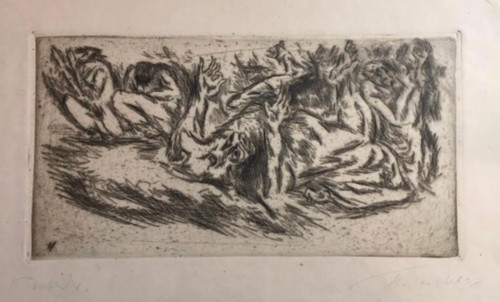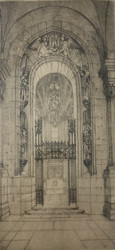Categories
Categories
- Home
- 20th Century Prints
- HEINRICH TISCHLER: "Troubel (Turmoil)" Etching Ca 1930 Pencil Signed Gold Frame
HEINRICH TISCHLER: "Troubel (Turmoil)" Etching Ca 1930 Pencil Signed Gold Frame
Product Description
|
Description: HEINRICH TISCHLER: "Troubel (Turmoil)" Etching Ca 1930 Pencil Signed Gold Frame Size: 4.5 x 9 image; 19 x 15 framed. Custom gold framed with inset & acid-free mat Condition: Very good; minor foxing, slight 3/4 inch bend upper right margin see photo Signed: Pencil sized and initialed in the plate Shipping: $25.00
Heinrich Tischler (1892-1938)
Heinrich Tischler was born in ( Kędzierzyn-Koźle) Cosel, Silesia, Poland in 1892. After graduating from high school, he did a carpentry apprenticeship and then worked in the building trade. From 1912 he attended the architectural and painting class at the State Academy of Arts and Crafts in Wroclaw.
He had experienced the First World War as a soldier. After the war, he worked as a freelance painter and architect in Wroclaw and the surrounding area. Among other things, he created the interior of the department store Petersdorff in Breslau from 1927 to 1928 and the reconstruction of the commercial building Gurassa in Opole .
Tischler was a friend of Otto Mueller, who had been teaching at the Breslau Academy of Art and Applied Arts, in Germany, since 1919. Tischler was a fellow instructor and friend of Mueller’s whose work was heavily influenced by Lovis Corinth as well as German Expressionism and French Impressionism alike.(other instructors included August Grisebach, Von Gosen, Wiicensus, Moll, Bednorz, Hanusch, Paul Heim, Franz Landsberger, Frederich Pautsch). Fully embodying the expressive aesthetic of German contemporary art of the era, Tischler is today a mostly under appreciated modernist.
Tischler painted, drew and produced etchings and lithographs. The main themes of his work were the bleak social conditions of the post-war period, using the stylistic devices of Expressionism . He won recognition as an artist in the 1920s, when his works were presented, among others, at exhibitions of the Berlin Secession. With the seizure of power of the National Socialists the career of Jewish Tischler came to a sudden end. After initial work prohibitions, interrogation and other harassment, he was sent to Buchenwald concentration camp in 1938, the year he died. Tischler's widow, who was able to save some of his paintings, managed to escape to Britain. The estate came into the possession of Kassel art collector Hans Peter Reisse , who sold it to the Silesian Museum in Görlitz with other works by artists belonging to the circle of the Wrocław Academy. A number of his works were part of the Ismar Littmann collection.
Courtesy Journal of Architectural Educations, Swann Galleries, Wroclaw.pl, ArtlinkArt, Wikipedia Ask Art |
 Loading... Please wait...
Loading... Please wait... 








